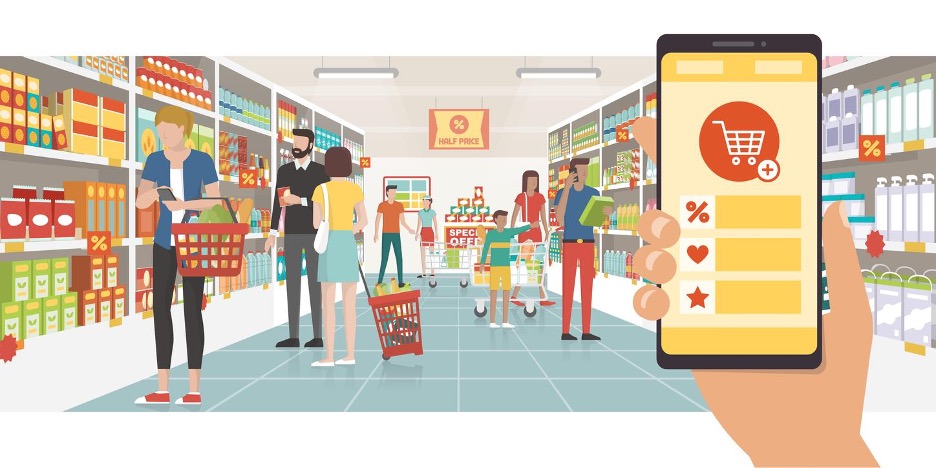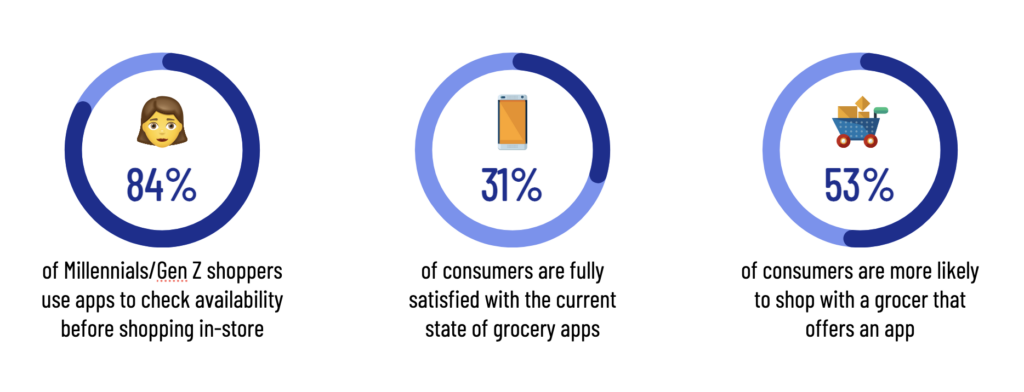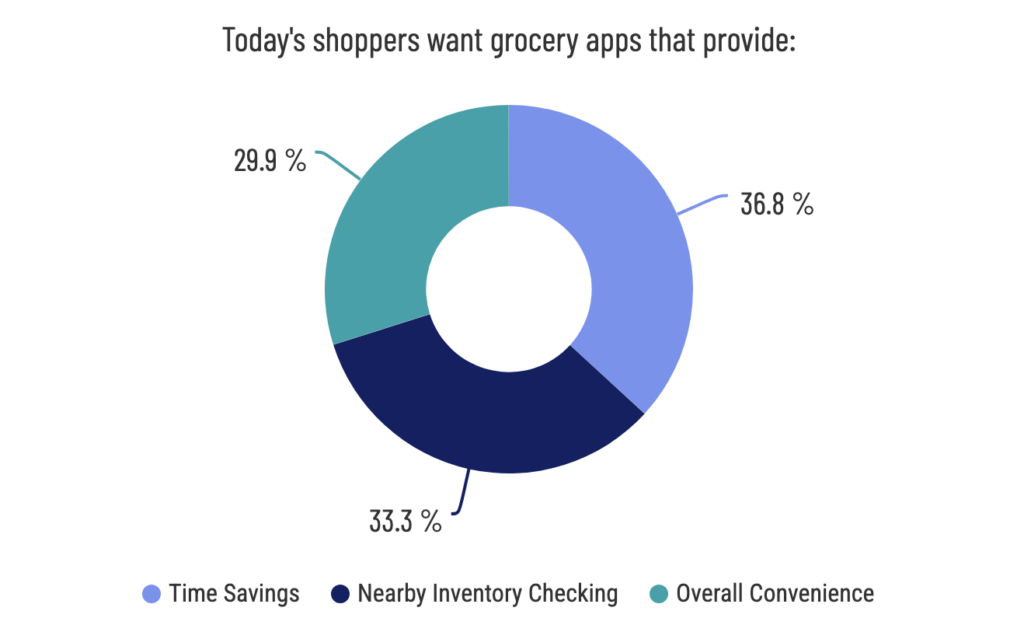Top Key Factors Why Grocers Need an App to Meet Consumer Expectations

We’ve all witnessed the growth of grocery apps in a short amount of time. Major chains offer grocery apps for easy ordering and delivery. Third-party services like Instacart make it simple for shoppers to get groceries from their favorite stores delivered straight to their door. This convenience and efficiency have turned consumer preferences away from what was once their only option.
With 1 in 3 grocery shoppers (33%) spending an average of $101 to $200 per grocery trip, it’s not surprising to us that people are constantly on the lookout for something that can simplify their shopping process—especially one that can also save them time and money. More of today’s shoppers are prioritizing value, convenience, flexibility, and personalization above all else. Mobile devices provide the ideal platform for delivering those benefits through features like seamless delivery, digital coupons, loyalty programs, in-app shopping lists and reminders, and product recommendations.
Grocers who successfully adapt to this mobile-first landscape can gain invaluable insights into their customers. They develop more intimate consumer relationships and open new streams of revenue through value-added app features.

Why Grocers Need a Mobile App to Meet Consumer Expectations
You may still be questioning the true power of mobile apps. You may want to know if more consumers truly prefer doing their grocery shopping on an app over “old-fashioned” in-store grocery shopping. What we have found is that mobile apps are the preferred way to shop for 39% of consumers compared to in-store grocery shopping. Additional research revealed that 53% of consumers are more likely to shop with a grocer that offers an app.
So, mobile apps indeed offer convenience and efficiency that more consumers prefer. Food and beverage apps allow shoppers to spend more time carefully reviewing their lists rather than rushing through a store. Consumers are growing more accustomed to the perks of skipping crowded store aisles and scoring deals and promotions from the comfort of their homes.
The global online grocery market is expected to experience a compound annual growth rate (CAGR) of 26.8% from 2022 to 2030. This anticipated growth will make the market reach a total value of 305.13 billion by 2030. These numbers signify a thriving industry with considerable implications for mobile apps. As the online grocery market continues to grow, grocery shoppers will expect feature-rich mobile apps. These will allow them to browse store inventory, place orders, and pay—all from their smartphones.
Grocers who prioritize building advanced mobile functionality now will thrive as digital transforms the industry—those who lag behind risk losing customers to more tech-savvy competitors. Currently, only 31% of consumers are fully satisfied with the current state of grocery apps. Deficiencies like inaccurate or outdated inventory information are diminishing the value that mobile apps can provide. Out-of-stock items and a lack of product availability transparency are also sources of frustration for many shoppers.
How Mobile Apps Are Transforming the Grocery E-Commerce Industry
There are some clear frustrations from grocery shoppers regarding the use of mobile apps. However, there is massive room for improvement in terms of mobile app development. The numbers suggest existing mobile apps may experience more usage and that there will be opportunities for new players and additional investment in developing or improving mobile app solutions dedicated to online grocery shopping.
Changing consumer habits and expectations are driving the shift toward mobile. In discussing the landscape of consumer expectations in the digital era, Lawrence Snapp, CEO of Bryj, talked about the key role that mobile devices play in the ongoing digital revolution within grocery e-commerce. Snapp shared, “Consumers today expect convenience and efficiency in every transaction and interaction. We’ve only just scratched the surface of the digital revolution within grocery e-commerce, and mobile devices are key to unlocking its full potential.”
As everything points toward a future where mobile apps will continue to have a starring role, grocers who proactively improve their digital offerings are poised to not just meet customer expectations but exceed them. These same grocers will also establish themselves as leaders in the digital grocery landscape.

Consumers Rely on Grocery Apps to Check Inventory and Shop In-Store
Mobile apps have become essential to the grocery experience. We found that 73% of consumers reported using apps to check inventory availability before shopping in-store. This number increases to 84% among Millennials and Gen Z shoppers. Providing real-time inventory visibility and transparency delivers tremendous value for converting mobile engagement into sales.
But insufficient insights were called out as a top frustration:
- 48% mentioned apps displaying out-of-stock items as available
- 30% mentioned products being missing from the app but being available in-store
This disconnect between digital and brick-and-mortar directly impacts sales. Grocery shoppers expect their mobile experience to accurately reflect what they’ll find in-store. Today’s shoppers want grocery apps that provide:
- Time savings (53%)
- Nearby inventory checking (48%)
- Overall convenience (43%)
When mobile apps show inaccurate availability, it damages credibility and causes shoppers to go somewhere else. By not properly syncing inventory across channels, grocers miss revenue opportunities and diminish the convenience mobile apps can provide. Advanced mobile technology, like AI and automation, allows up-to-the-minute accuracy across digital and physical stores.
Delivering on these expectations is crucial for customer acquisition and loyalty. Grocers without a strong mobile presence will struggle to attract and retain consumers. The research makes it clear that while consumers want grocery apps, flaws lead to displeasure. 20% of consumers are unhappy with their mobile app experience, and 49% are only somewhat satisfied and want improvements.
A few key improvements consumers want include:
- Accurate real-time inventory (58%)
- Personalized promotions (47%)
- Restock visibility (41%)
Meeting these demands will require grocers to invest more in mobile technology and innovation. However, the opportunity is there to provide seamless, personalized experiences. Investing in mobile technology and innovation is not just necessary—it’s a chance to revolutionize shopping. Imagine a grocery app where shoppers can trust products are in stock, get personalized promotions that fit their needs, and be notified about restocks. Embracing these improvements provides a chance to make your mobile app something that solidifies your place as a top grocery provider.
A Grocery Shopping App Elevates Your Business and Strengthens Your Brand
The integration of a grocery app into your business strategy is more than an upgrade—it’s a strategic leap. This digital evolution goes beyond daily transactions, promising to reshape customer interactions and take your grocery store higher in the process. Here are just a few ways the right mobile app can strengthen your brand:
Creates a Convenient and Time-Efficient Shopping
A well-designed mobile app streamlines the shopping process, providing customers with a convenient and time-efficient way to fulfill their grocery needs. With features like one-click ordering, saved shopping lists, and easy navigation, this quickly contributes to an enjoyable user experience. The more effortless and enjoyable the shopping journey, the more positively your brand will be viewed.
Allows You to Crack the Code on Customer Behavior
A grocery store mobile app can capture valuable data on customer preferences, purchase history, and shopping patterns. By utilizing advanced analytics, you gain true insights into consumer behavior. This invaluable information allows you to personalize your offerings, promotions, and marketing strategies to correctly meet the evolving needs of your customer base.
Allows You to Deliver Personalized Shopping Experience
Holding on to the power of artificial intelligence, mobile apps can offer personalized recommendations based on customer preferences. From suggesting relevant grocery store items to providing exclusive discounts, this experience does more than enhance customer satisfaction. It also fosters brand loyalty. The more personalized and intuitive you can make the shopping journey, the stronger the connection your customers will feel with your brand.
Allows You to Master the Art of Inventory
Properly executing a grocery shopping mobile app allows for real-time inventory tracking and management. This not only minimizes the risk of stockouts but also paves the way for efficient supply chain operations. When you can maintain optimal inventory levels, you improve customer satisfaction by making sure that the items they need the most are consistently available.
Why Bryj Is the End-to-End Mobile App Solution Grocers Need
We understand the growing needs of grocers in an active and competitive landscape of consumer preferences. Our end-to-end mobile app solutions are tailored to empower grocers with the advanced technology that is needed to meet the needs and wants of today’s consumers.
Our AI-powered platform ensures real-time inventory accuracy, hyper-personalization, and unified commerce experiences, understanding and addressing the key challenges grocers are facing today. Also, our tools are purpose-built to deliver the features that consumers expect from grocery apps. With Bryj, you can offer go-to features like convenient self-checkout, efficient curbside pickup, reliable delivery tracking, digital coupons and loyalty programs.
Are you ready to revolutionize your grocery offerings? Contact Bryj today and let us take you on a journey that will unlock the true potential of your grocery store. Let’s shape the future of grocery retail together—one powerful and efficient mobile app at a time.


